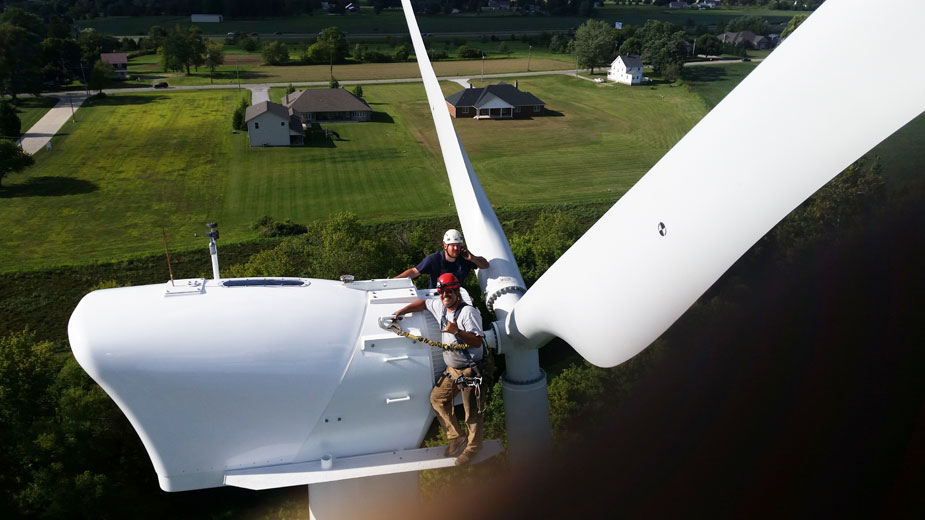Companies Catch the Wind that Powers Energy Projects
YOUNGSTOWN, Ohio – Energy production in Ohio derived from wind might be caught in the doldrums, but companies across the state are turning out the components, mechanisms and technical expertise needed to propel the industry.
“We’ve got projects in nine states right now,” reports Greg Courtney, founder and principal of Wind Turbines of Ohio LLC, based in Alliance. The company installs wind turbines throughout the United States for military bases, schools, small businesses and residential customers.
Among the more recent projects the company completed is what Courtney says is the largest micro-grid system outside of California. On the campus of Holy Love Ministries in North Ridgeville, just west of Cleveland, is a micro-grid that involves a combination of wind and solar energy fed through the ministry’s own system. That is, all of the power generated at the campus is self-contained and used entirely by the ministry; it is not governed by an outside electrical power grid.
“The ministry wanted to be able to run the 160-acre campus off-grid in the event of a failure,” Courtney says. The company worked with Zenith Systems, which provided a 300-kilowatt solar array, while a manufacturer in Vermont supplied two 100-kilowatt Northern Power wind turbines for the project.
The wind turbines, mounted atop towers 120 feet tall, are spaced 400 feet apart.
“Based upon the wind speeds in North Ridgeville, we expect each of the wind turbines to produce 225,000 kilowatt hours of electricity annually,” Courtney says.
A turbine weighs 12,000 pounds, the towers another 33,000 pounds each, he says.
“The whole industry is migrating to these micro-grids,” Courtney notes, which incorporate a hybrid of solar and wind into their system.
Small companies that rely solely on wind business are getting clobbered in the market because the price of solar energy has dropped considerably. This shift persuaded Wind Turbines of Ohio to diversify and move into solar. “It’s about 50% of our business,” he says.
Courtney founded the company in 2007 and that year installed 19 wind turbines. By the end of 2012, the company had installed 170 turbines across seven states and constructed wind power systems for farms, wineries, schools and companies such as Myers Equipment Corp. in Canfield.
A sister company, Wind Turbines of South Carolina LLC, handles the Southern market, Courtney notes.
New regulations, however, mixed with the expiration of federal tax credits that subsidize alternative energy and the reduced costs of solar, have staunched the growth of the wind industry in Ohio, he says, especially building new installations.
Even with all that, he believes the potential for new business in the wind industry is “explosive,” noting that service work will be in great demand as the industry evolves.
“It’s projected that the industry will need 275,000 wind turbine technicians over the next five years,” Courtney says.
While Ohio isn’t exactly on the fast track in developing wind energy as an alternate source of power, its manufacturing base sees the benefits of grid conversions across the country and in Europe.
According to the American Wind Energy Association, Ohio leads the country in the number of manufacturers that produce components for the industry. None of these manufacturers makes the large turbines and the heavy equipment – blades and towers, for example – but they do supply the important smaller functional pieces such as gears, bearings, hydraulic systems, resins, assembly services and coils.
More than 60 plants across the state produce some type of subcomponent for the wind industry, the trade group says. In 2014, the industry supported as many as 2,000 jobs and realized total capital investment of $775 million.
So how did Ohio become a leading manufacturing center for the wind industry? The state isn’t known for its strong steady winds: The two regions best-suited are Lake Erie and the northwestern quadrant.
“When the economic downturn hit in 2008 and 2009, a lot of manufactures in Ohio that did work for the auto industry lost a lot of that business and had this CNC machining capacity,” says Gerard Sposato, vice president of sales at Argosy Wind Power in Aurora. “Wind turbines filled these needs when auto went away.”
Argosy manufactures small-scale wind turbines suited to family farms and universities, Sposato says. “We haven’t done any business in Ohio,” he laments. The company buys finished components and then assembles the larger parts in Aurora.
Most of its business at the moment is overseas. “The U.S. market is soft,” Sposato says. “A high percentage of what we sell is out of the country.”
Federal tax credits that supported development of the industry for residential and small businesses have expired, although credits and grants through the U.S. Department of Agriculture used to offset wind energy development in rural communities remain intact, Sposato says.
“Our biggest customers in the U.S. are farms in Iowa, Minnesota and the Midwest,” he relates.
Alternative energy programs in European countries, on the other hand, are heavily subsidized through what are called feed-in tariffs, or FITs. “In this case, the government pays people to put up turbines,” he says, enhancing the opportunities for U.S. manufacturers.
Probably the biggest challenge the wind industry in Ohio faces is the state’s failure to put in place meaningful renewable energy standards. In 2008, the General Assembly passed legislation that would require utilities to generate 25% of their electrical power from alternative energy sources such as wind or solar by 2025. The program was to be phased in over that period.
But two years ago the Legislature passed a measure freezing implementation of these new standards. And in mid-April, state Sen. Bill Seitz, a Republican from Cincinnati, began circulating draft legislation that would extend the freeze another three years.
“The policy environment has changed in Ohio, creating challenges,” says John Colm, president and executive director of Wire-Net, a nonprofit economic development organization in Cleveland that works with manufacturers on energy efficiency. It is also the home of the Great Lakes Wind Network, a network of manufacturers and suppliers that serve wind energy development in the state.
Recently, Wire-Net completed an assessment for the U.S. Department of Energy that found demand in the industry has slackened, and that those manufacturers still in business have had to reorganize their supply chains.
For example, the number of original equipment manufacturers across the country building and installing these giant wind turbines stood at 28 in 2012. “Now, there’s about six or seven,” Colm says, noting the industry is dominated by big players such as GE Renewable Energy, Siemens and Vestas.
Many Ohio manufacturers invested heavily in their operations to accommodate the wind industry, Colm says. “And then the tax credits expired. What saved a lot of them was the boom in shale gas.”
The freeze on renewable standards, combined with new setback requirements for wind turbines, make it tougher for those with smaller plots to construct towers. They have “killed the wind industry and driven a lot of companies out,” Colm says.
Still, the uncertain market hasn’t deterred others from pursuing ambitious wind energy projects.
“Ohio has come very late to wind energy,” says Lorry Wagner, president of Leedco, a company seeking to develop a pilot wind project in Lake Erie, about 10 miles north of downtown Cleveland. The developer wants to install six large wind turbines in the lake, which would produce about 20 megawatts of electricity, enough to supply power to somewhere between 6,000 and 8,000 homes.
Not only could the South Shore Wind Project and initiatives like it provide a reliable, renewable source of power to the public, the environmental benefits “are incalculable,” Wagner says. “We still have some of the dirtiest air in the country and incredibly high asthma rates, especially in inner-city Cleveland,” he says. “So, how do you make a dent in that? Part of it is to generate clean energy locally.”
Inland wind power isn’t likely to have a big impact, Wagner says. A wind farm on a usually windy, sometimes blustery, Lake Erie, however, probably stands the best chances of success. Building this wind project initiates a long-term development process that could place Ohio companies in a better position to supply the industry as it grows. “We’re looking ahead at where we’re going to be in 10 to 25 years,” Wagner says, “and trying to be in a position to compete. That’s what our project is really about.”
Wagner expresses hope that the $120 million wind initiative would be in operation sometime in 2018. Bid packages have been sent to suppliers and manufacturers and five firms in the Midwest – some are Ohio companies – and three in the Gulf of Mexico region interested in the project.
“It’s to get the experience and develop the supply chain,” Wagner says. “As projects come up around the country, we’re in a perfect position to help companies compete in projects in the Atlantic.”
Pictured: Sam Courtney and Paul Laferriere pose atop a large wind turbine the company installed.
Copyright 2024 The Business Journal, Youngstown, Ohio.



